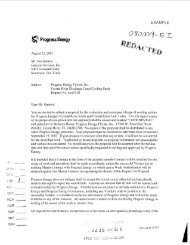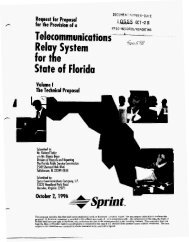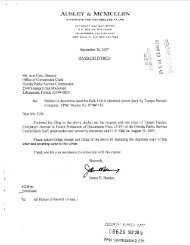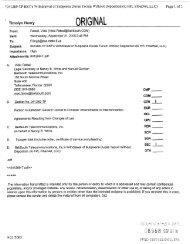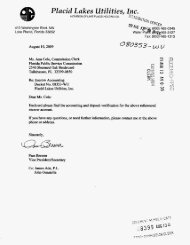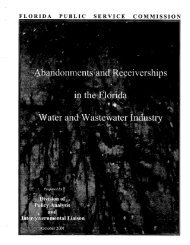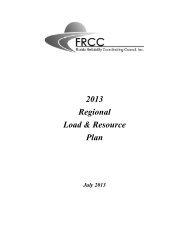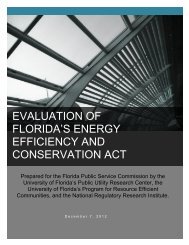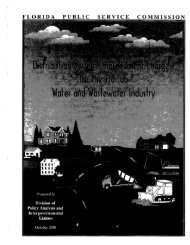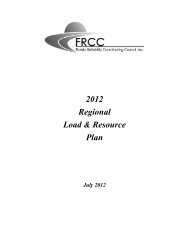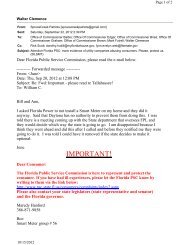Review of 2008 Ten-Year Site Plans - Public Service Commission
Review of 2008 Ten-Year Site Plans - Public Service Commission
Review of 2008 Ten-Year Site Plans - Public Service Commission
Create successful ePaper yourself
Turn your PDF publications into a flip-book with our unique Google optimized e-Paper software.
1. Demand-Side Management (DSM) and Conservation<br />
The first step toward building an energy efficient Florida begins with minimizing the load and<br />
energy requirements which the utilities must serve. Reduced load and energy requirements are<br />
essential in decreasing the burning <strong>of</strong> fossil fuels and deferring the need for additional generating<br />
capacity. Load and energy requirements are affected by many variables including population growth,<br />
demographics, and weather patterns. Customer choice, however, serves as the foundation for wise<br />
energy use in order to reduce dependence on expensive liquid fuels and reduce greenhouse gas<br />
emissions.<br />
Utilities play an important role in educating consumers to make wise energy choices.<br />
Through DSM programs, Florida’s utilities can have a direct effect on customer energy usage patterns.<br />
Florida’s investor-owned utilities (IOUs) have reported more than $250 million in conservationrelated<br />
expenditures in 2007, marking the highest expenditures since 1999. Expenditures in <strong>2008</strong> are<br />
projected to exceed $285 million. This trend illustrates the commitment <strong>of</strong> Florida’s utilities to DSM<br />
and energy efficiency. However, per capita energy consumption is projected to increase.<br />
Over the planning period, Florida’s utilities are projecting more than 7,600 MW <strong>of</strong> summer<br />
peak load reduction from DSM and energy efficiency programs. The demand reductions projected in<br />
the <strong>2008</strong> <strong>Ten</strong>-<strong>Year</strong> <strong>Site</strong> <strong>Plans</strong> are based on goals which represent a minimum threshold utilities must<br />
meet before building any major power plants. Overall, demand and energy savings from utilitysponsored<br />
DSM and energy efficiency programs are expected to surpass current goals by as much as<br />
60 percent. The utilities’ current goals were set by the <strong>Commission</strong> in 2004.<br />
In <strong>2008</strong>, the Legislature amended Section 366.82, F.S., which expands the <strong>Commission</strong>’s<br />
process for establishing DSM and energy conservation goals. More specifically, the <strong>Commission</strong><br />
must now consider the impact <strong>of</strong> demand-side renewable energy systems as well as an expanded<br />
scope <strong>of</strong> potential conservation and efficiency measures. Additional considerations include the need<br />
for incentives and the effect <strong>of</strong> emission compliance costs. Utilities have launched a technical<br />
potential study to start the goal setting process, and a hearing date is set for August 2009. New goals<br />
will be set in December 2009 and should be reflected in the utilities’ 2010 <strong>Ten</strong>-<strong>Year</strong> <strong>Site</strong> <strong>Plans</strong>.<br />
2. Renewable Generation<br />
Renewable generation is another key component <strong>of</strong> building an energy efficient Florida.<br />
Currently, approximately 1,000 MW <strong>of</strong> renewable generation are available in Florida. Roughly 450<br />
MW are sold to Florida’s utilities as firm capacity; the remaining capacity is either sold on an asavailable<br />
basis or used internally by customers. If all three forms <strong>of</strong> renewable energy – firm, nonfirm,<br />
and self-service – are combined, data suggests that renewable energy accounted for 3.6 percent<br />
<strong>of</strong> the IOUs retail energy needs in 2007.<br />
Historically, relatively high capital and operating costs as well as limited physical applications<br />
have hampered the development <strong>of</strong> renewable energy in the state. The <strong>2008</strong> <strong>Ten</strong>-<strong>Year</strong> <strong>Site</strong> <strong>Plans</strong><br />
indicate approximately 500 MW <strong>of</strong> new renewable capacity are presently planned through the year<br />
2017. Current utility-owned generation is approximately 50,000 MW, so the contribution toward fuel<br />
diversification from renewable energy remains relatively small.<br />
<strong>Review</strong> <strong>of</strong> <strong>2008</strong> <strong>Ten</strong>-<strong>Year</strong> <strong>Site</strong> <strong>Plans</strong> - 2 -




